Today, LEDforum Shanghai 2011 commenced at Jumeirah Himalayas Hotel Shanghai with a full house. Executives of the world’s leading companies not only presented the latest and highly relevant information regarding product designs, technologies, end-market applications, market trend of the LED industry, but also provided an in-depth analysis and a cutting-edge report on the global LED industry. Today was the first day of LEDforum Shanghai 2011, which consisted of the opening ceremony including major manufacturers around the world, the keynote speech, and a complete analysis of upstream market of the LED industry.
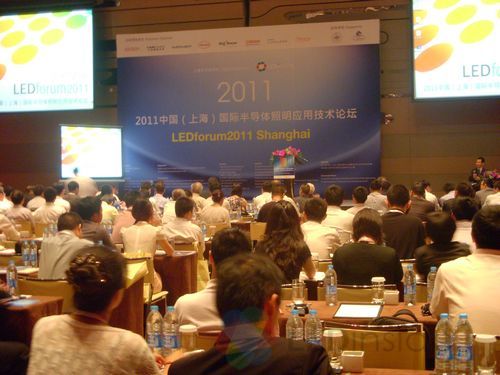
The First Day of LEDforum Shanghai 2011
The first day of LEDforum Shanghai 2011 began with the opening speech and welcome speech by the Shanghai Municipal Government leader and the Head of Science and Technology Commission and the welcome speech by C.L. Liu Ph.D., the Chairman of TrendForce Corp., followed by an introduction by Chu Junhao, Ph.D., the Director Assistant and Deputy Director at Shanghai Research Center of Engineering and Technology in Solid State Lighting, to the 12th Five-year Plan regarding the solid-state lighting industry in Shanghai. Afterward, the speeches of the first day started.
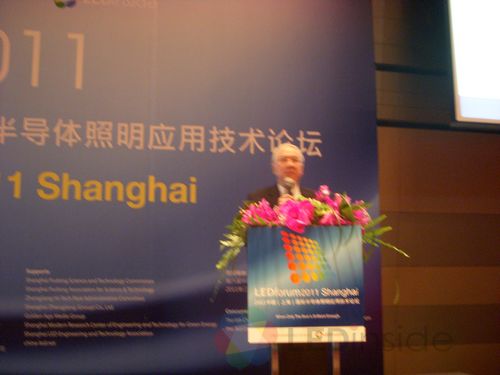
In his speech, C.L. Liu, Ph.D. used the example of gaining property and the anecdote of the diplomat meeting President Clinton to elaborate the importance of innovation. His example and anecdote established a professional, intellectual and witty tone for the forum.
Shanghai Research Center of Engineering and Technology in Solid State Lighting: The Core Competitiveness of Semiconductor Lighting in China
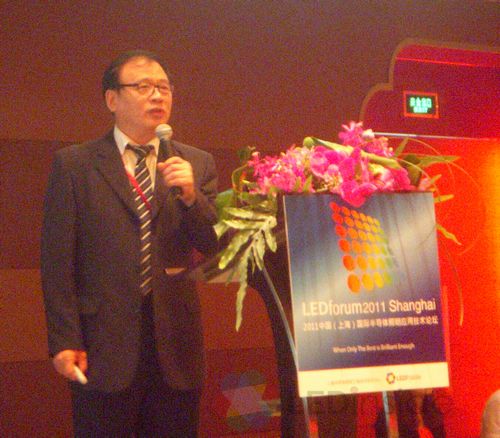
In light of the fact that China is not only an emerging country but also an emerging LED market, Chu Junhao, Ph.D of Shanghai Research Center of Engineering and Technology in Solid State Lighting addressed the core competitiveness of semiconductor lighting in China from the performance and direction perspectives of the core competitiveness.
He pointed out the fact that the incandescent products of Chinese manufacturers are three to four times cheaper than imported products as an example to demonstrate his point: the scale production does not equal to the core competitiveness. He indicates that the difference of integrated factors among domestic products and the overemphasis on the midstream and downstream market will lead to a resource competition between manufacturers. The different sectors of the industry chain have to be foundation of the core competitiveness.
He further indicated that because the solid-state lighting industry is underpinned by advanced technology, the Chinese solid-state lighting makers need to start from the MOCVD sector and in the meantime, develop other core technologies in order to establish the core competitiveness. Moreover, the adoption of high-end technology and the comprehensiveness of technology system are nothing short of crucial as well.
Philips Lighting: Global Trends in LED Lighting Systems
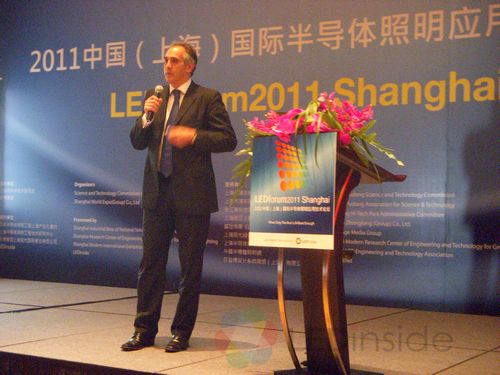
Philips Lighting has been in a leading position among the global lighting industry and is striving to raise energy-saving awareness in the society.
Jaap Schlejen, the Vice President of Philips Lighting, provided not only an in-depth analysis of the trend of the lighting market in scenery, outdoor, and office sectors but also a comprehensive conclusion of the LED lighting system market, which threw light on the future development of the LED lighting market.
Furthermore, he utilized data to estimate the value growth of the LED market in the future. He believed that the penetration rates of LED and controlling technology will grow considerably among future lighting applications. Such a growth will alter the landscape of competition and accelerate the change to the lighting resource, module and total solution markets.
Schlejen also indicated that, according to his data, the value of LED market will account for 60% of the total market value by 2015. In addition, the outdoor lighting market has been showing promise and the retail sales have been on an increase. Also, office and industry lighting markets are on the verge of booming growth.
University of California, Santa Barbara: Current Status of Solid State Lighting Market
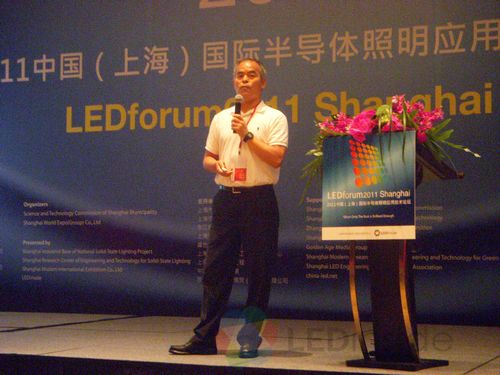
Shuji Nakamura, Ph.D., the inventor of the first high brightness gallium nitride (GaN) LED, addressed the current state and future trend of solid-state lighting market from a professional and research perspective.
He analyzed the different equipment of GaN LED from the structural drawings of nonpolar molecule and semi-polar molecule. Also, he explained the increase of the bulk GaN crystal.
Shuji Nakamura, currently a professor of Materials Department of the University of California, Santa Barbara, received B.E., M.S., and Ph.D. degrees in Electrical Engineering from the University of Tokushima, Japan in 1977, 1979, and 1994, respectively. He, widely known as the “Thomas Edison of the LED industry,” developed the first groupIII nitride-based blue/green LEDs and group-III nitride-based violet laser diodes (LDs) in the world.
In addition, he successfully developed the first commercially viable white LEDs based on GaN, which becomes an integral part of the booming development of the global LED industry.
OSRAM: Prospects for Global Solid-State Lighting Market
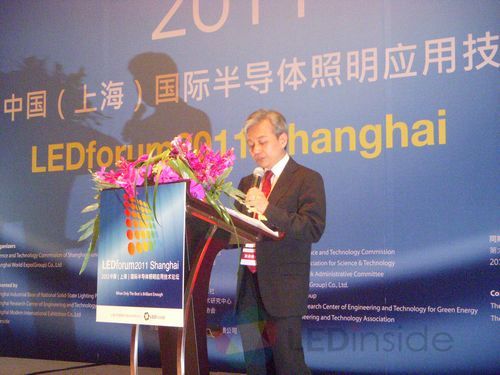
OSRAM, which owns a number of world-leading patents and has provided numerous world renowned constructions with lighting products and solutions, is not only one of the major lighting companies in the world but also an innovative LED lighting company. Benjamin Tan., VP of Sales of Osram Asia Pacific provided his insight into the global market of solid-state lighting.
Benjamin Tan stated that the future goal of the LED industry is to optimize the products in every aspect. The size of wafer has become bigger and bigger: it developed from 2-inch to 6 and 8-inch. Osram has started its first 6-inch wafer production in 2011.
OSRAM already began dedicating to the development of new light source since the last century and prided itself in being one of the first companies to launch white light LED products. Currently, OSRAM’s products have made their ways into car, signal light and building markets. OSRAM states that the popularization of LED in lighting applications is still at the initial stage, because presently, most of the LED applications are street lamps or for specific usages, which account for a mere portion of sales in the lighting market. It is expected that LED will take up a bigger share in the household lighting market in the future.
GE Lighting: LED Systems Design for Application
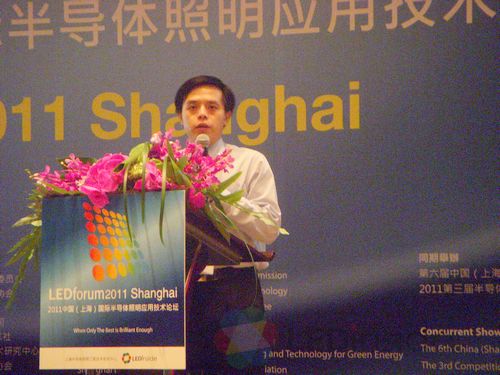
The afternoon sessions began with a unique insight into the lighting product quality provided by Samuel Wang, the Product General Manager of GE Lighting Asia LED. Mr. Wang also interacted and discussed the LED applications with the audience.
His speech not only addressed quality assurance and introduced the formula of return on investment, but also covered topics of LED energy-saving applications and the cost.
Moreover, the unparalleled performance and innovative design of GE’s products, including GE Module Roadway R250 Series, were also demonstrated in the speech.
VEECO: Reducing LED Manufacturing Costs through Advancements in MOCVD Technology
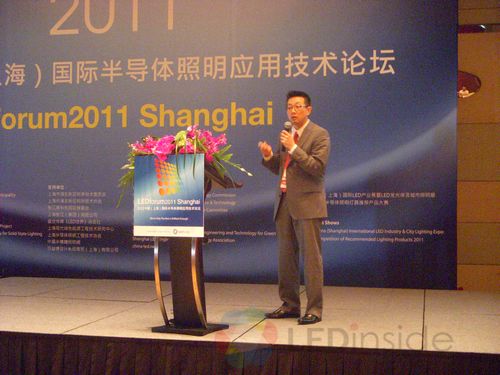
Jia Lee, the Director of Marketing of Veeco Instruments, addressed “Reducing LED Manufacturing Costs through Advancements in MOCVD Technology.”
Mr. Lee expected the penetration rate of LED TV to reach 50% in 2011 and to advance to 80% in 2013. He also predicted that the increasing rate of LED chips will reach 68% in the next five years. In addition, with the fast growth of the LED industry, he provided relevant data to demonstrate how the advancement of MOCVD equipment is able to aid manufacturers in reducing costs, provide a system for designing high-brightness LEDs, increase capacity and decrease carbon emission.
In May, 2011, Veeco inaugurated its new Customer Support & Training Center in Shanghai which was about 1700 square meters in size and accommodated approximately 40 Veeco employees. The center is equipped with three classrooms as well as Veeco’s market leading Veeco TurboDisc® K465i™ MOCVD system.
AIXTRON: Improving Production Quality and Efficiency of MOCVD Market
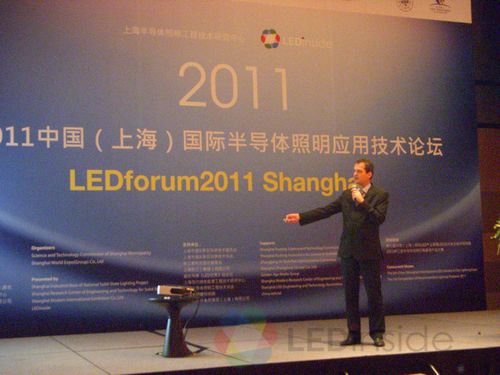
Christian Geng , Ph.D., the Vice President Greater China, AIXTRON, offered his exceptional insight into the new outlook created by improving production quality and efficiency of MOCVD market.
To start his speech, Mr. Geng introduced AIXTRON’s products by citing relevant news reports, and then gave concrete analyses of production quality as well as efficiency: the former included chip quality, growth pressure, product consistency and prevention of dust particle; the latter included capacity, the size of wafer and increasing rate and automation.
Taking customers’ demands into accounts, AIXTRON develops its MOCVD equipment with the aim of helping manufacturers reduce production cost, increase efficiency and expand capacity.
KLA-Tencor: How to Do Automated Inspection of HB-LED wafers for Quality
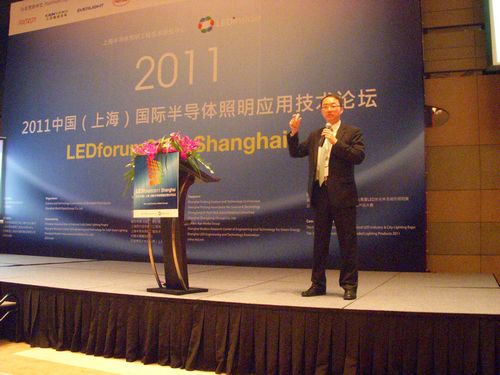
Francis Jen, Ph.D., the China Region Technical Director of KLA-Tencor, explained its HB-LED manufacturing process solution, manufacturing process, the demand of inspection in production line with the aid of assorted charts and information. In addition, he also shed light on the procedure of LED wafer automatic inspection and electronic detection strategy with several examples.
Mr. Jen believed that the inspection and management of manufacturing process is one of the pressing elements of the LED industry. KLA-Tencor, specializing in improving the yield rate of semiconductors and providing total solutions of manufacturing process inspection and management, has been not only dedicating to product research and improvement and providing better equipment service but also helping semiconductor makes manufacturer products with higher quality and efficiency. Currently, KLA-Tencor’s branch companies are located in more than ten countries of America, Europe and Asia.
At last, he expressed the bright outlook he saw for the Chinese LED industry in hope that China will become one of the major LED manufacturing countries in the world.
Carbon TEQ Solutions: Heat Management in Lighting Applications and New Technologies to Manage Heat
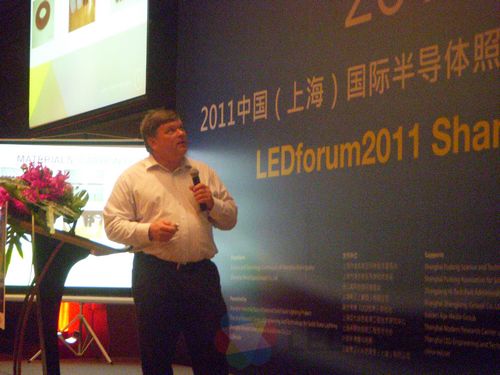
Bill Scalia, the Vice President and Chief Technology Officer of Carbon TEQ Solutions, presented his insight into heat management in lighting applications and new technologies to manage heat. His speech covered different sections such as carbon foam material and the methodology, research, design and science of TEQ2.
In the science section, he introduced a new molecular structure named ScaliaPhysics™ which he developed. In addition, with his expertise in heat dissipation technology, Bill Scalia has successfully helped his clients reduce the energy consumption and the maintenance cost as well as extended the lifespan of products with TEQ Methodology.
Mr. Scalia’s specialty and dedication to heat dissipation products are the reason Carbon TEQ adopts his patent in its products. In addition, he demonstrated a video of product experiment at LEDforum.
LEDinside (TrendForce Corp.): Solid-State Lighting/LED Market Trend in 2012
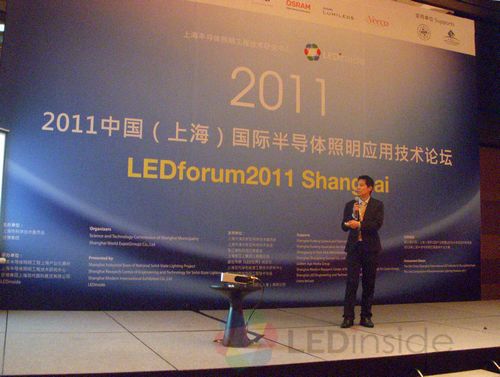
Due to the fact that the development of LED industry has been the focus of relevant industries over the past few years, Roger Chu, the Research Director of LEDinside, presented a comprehensive report on “Solid-State Lighting/LED Market Trend in 2012.”
Mr. Chu’s report mainly included the estimation of the development trend, the outlook on both ends of supply-and-demand chain and the competition and cooperation of the LED industry. He pointed out that due to the rise of Chinese and South-Korean LED market, the LED price has more or less shown a decline in NB, TV, mobile device applications over the past few years. According to his report, the demand of HB LED will continue increasing in the coming years.
He pointed out that the focus of the TV market has shifted to 3D sector, which results in a decrease in the LED penetration rate. Scenery lighting accounts for the biggest market share in 2010. He stated that currently, many countries have enact policies to support the LED industry. He used the loan policy by the South Korean government as an example to demonstrate his point.
Mr. Chu indicated that the LED penetration rate in Japanese market, which reached 18 to 20% in 2010, has increased by 20 to 30% due to the Japan earthquake. He believed even though the increase rate will slow down in July and August, but the increase will continue.
Besides, he also analyzed the upstream and downstream of the LED industry, including MOCVD, sapphire substrate and other sectors, and predicted the subsidy policies enacted by different governments.











